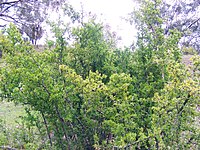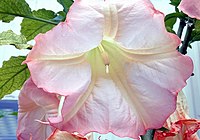
Fruit ripening in Lycium barbarum and Lycium ruthenicum is associated with distinct gene expression patterns
Sign Up to like & getrecommendations! Published in 2020 at "FEBS Open Bio"
DOI: 10.1002/2211-5463.12910
Abstract: Goji berries have been used as food and medicine for millennia. Due to their high morphological similarity, fruits of two distinct species belonging to the family Solanaceae, Lycium barbarum (LB) and Lycium chinense (Chinese boxthorn),… read more here.
Keywords: lycium; fruit; lycium ruthenicum; expression ... See more keywords

Genetic diversity and morphological variation in African boxthorn (Lycium ferocissimum) – Characterising the target weed for biological control
Sign Up to like & getrecommendations! Published in 2020 at "Biological Control"
DOI: 10.1016/j.biocontrol.2020.104206
Abstract: Abstract Lycium ferocissimum (African boxthorn) is a Weed of National Significance in Australia. Biological control may have potential to manage this weed, but taxonomic uncertainty needs to be addressed first to facilitate searches for potential… read more here.
Keywords: south africa; lycium ferocissimum; african boxthorn; biological control ... See more keywords

Evaluation of fruit characteristics of various organically-grown goji berry (Lycium barbarum L., Lycium chinense Miller) species during ripening stages
Sign Up to like & getrecommendations! Published in 2021 at "Journal of Food Composition and Analysis"
DOI: 10.1016/j.jfca.2021.103846
Abstract: Abstract The fruits of three Lycium barbarum genotypes (HZR1, HZR2, HZR3) and a Lycium chinense genotype (M1 ALTUNI) harvested at various ripening stages (green, unripe, ripe) were compared based on some pomological properties (fruit length,… read more here.
Keywords: goji berry; lycium barbarum; lycium chinense; lycium ... See more keywords

Phenylpropanoid glycosides from the fruit of Lycium barbarum L. and their bioactivity.
Sign Up to like & getrecommendations! Published in 2019 at "Phytochemistry"
DOI: 10.1016/j.phytochem.2019.04.017
Abstract: Fifteen phenylpropanoid glycosides, including six undescribed compounds were isolated from the fruit of Lycium barbarum L. (Solanaceae) (goji or wolfberry). Their structures were identified by detailed spectroscopic analyses. Seven known compounds were firstly isolated from… read more here.
Keywords: fruit lycium; lycium barbarum; phenylpropanoid glycosides; lycium ... See more keywords

Physiological response of four wolfberry (Lycium Linn.) species under drought stress
Sign Up to like & getrecommendations! Published in 2018 at "Journal of Integrative Agriculture"
DOI: 10.1016/s2095-3119(17)61754-4
Abstract: Abstract We studied gas-exchange, chlorophyll pigments, lipid peroxidation, antioxidant enzymes, and biomass partitioning responses in seedlings of four wolfberry species (Lycium chinense Mill. var. potaninii (Pojark.) A. M. Lu, Lycium chinense Mill., Lycium barbarum L.,… read more here.
Keywords: drought stress; species drought; four wolfberry; chinense mill ... See more keywords

Wolfberry genomes and the evolution of Lycium (Solanaceae)
Sign Up to like & getrecommendations! Published in 2021 at "Communications Biology"
DOI: 10.1038/s42003-021-02152-8
Abstract: Wolfberry Lycium , an economically important genus of the Solanaceae family, contains approximately 80 species and shows a fragmented distribution pattern among the Northern and Southern Hemispheres. Although several herbaceous species of Solanaceae have been… read more here.
Keywords: gene families; solanaceae; wolfberry; lycium ... See more keywords

Association of Two Bactericera Species (Hemiptera: Triozidae) With Native Lycium spp. (Solanales: Solanaceae) in the Potato Growing Regions of the Rio Grande Valley of Texas
Sign Up to like & getrecommendations! Published in 2022 at "Environmental Entomology"
DOI: 10.1093/ee/nvac109
Abstract: Abstract Bactericera cockerelli (Šulc) (Hemiptera: Triozidae) is a vector of ‘Candidatus Liberibacter solanacearum’ (Lso), the pathogen that causes potato zebra chip. Zebra chip incidence varies regionally, perhaps because of geographic differences in species of noncrop… read more here.
Keywords: solanales solanaceae; texas; bactericera; native lycium ... See more keywords

De novo characterization of the Goji berry (Lycium barbarium L.) fruit transcriptome and analysis of candidate genes involved in sugar metabolism under different CO2 concentrations.
Sign Up to like & getrecommendations! Published in 2019 at "Tree physiology"
DOI: 10.1093/treephys/tpz014
Abstract: Goji berry (Lycium barbarum L.) is one of the important economic crops due to its exceptional nutritional value and medicinal benefits. Although reduced sugar levels in goji berry exposed to long-term elevated carbon dioxide (CO2)… read more here.
Keywords: sugar metabolism; fruit; berry; lycium ... See more keywords

ABA mediates development-dependent anthocyanin biosynthesis and fruit coloration in Lycium plants
Sign Up to like & getrecommendations! Published in 2019 at "BMC Plant Biology"
DOI: 10.1186/s12870-019-1931-7
Abstract: BackgroundAnthocyanins, which are colored pigments, have long been used as food and pharmaceutical ingredients due to their potential health benefits, but the intermediate signals through which environmental or developmental cues regulate anthocyanin biosynthesis remains poorly… read more here.
Keywords: fruit coloration; biosynthesis; fruit; anthocyanin biosynthesis ... See more keywords

Quality control of Lycium chinense and Lycium barbarum cortex (Digupi) by HPLC using kukoamines as markers
Sign Up to like & getrecommendations! Published in 2017 at "Chinese Medicine"
DOI: 10.1186/s13020-016-0121-x
Abstract: BackgroundLycii Cortex (LyC), composed of Lycium chinense and Lycium barbarum cortex and having the Chinese name Digupi, is used to treat chronic diseases like cough, hypertension, and diabetes in Eastern Asia. However, chromatographic methods, such… read more here.
Keywords: lycium chinense; lycium barbarum; chinense lycium; quality control ... See more keywords

Characterization of the Lycium barbarum fruit transcriptome and development of EST-SSR markers
Sign Up to like & getrecommendations! Published in 2017 at "PLoS ONE"
DOI: 10.1371/journal.pone.0187738
Abstract: Lycium barbarum, commonly known as goji, is important in Chinese herbal medicine and its fruit is a very important agricultural and biological product. However, the molecular mechanism of formation of its fruit and associated medicinal… read more here.
Keywords: lycium; fruit; ssr markers; est ssr ... See more keywords